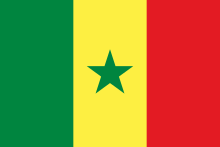It has been suggested that this article be merged into Senegalese hip-hop. (Discuss) Proposed since December 2024. |

Following an historical process of appropriation of American popular music by Senegal,[nb 1] hip hop emerged in the Senegalese capital city in the early mid- 1980s. Although hip hop galsen is now famous for its diverse musical productions, the movement there spread out from its dancing appeal rather than from its musical one. Indeed, Senegalese hip hop artists initially participated in this movement as smurfer, breakdancer, B-boy in general performing during organised podiums. Schools, nightclubs and other temporary public stages thus played an essential role in amplifying this movement in Dakar. Besides, and in contrast to American hip hop, which grew from the youth in the inner city ghettos, hip hop in Dakar began among a somehow middle-class youth who was able to access and/or introduce in their home place new ideas and new cultural expressions coming from abroad.[1] Indeed, hip hop became popular in the capital city through the intensive through informal circulation of VH7 cassettes and recorded videos, which were imported from USA (Africa Bambaataa) or France (hip hop dance TV show HIPHOP animated by Sydney) by diaspora people.[2]
Quickly, podiums enlarged their performances from dancers only to rappers as well. It was a time when soon-to-be hip hop artists were still mimicking American artists they actively used to listen to such Africa Bambaataa, Grandmaster Flash, Furious Five, Delight, Doug E. Fresh or Public Enemy for the most well-known. Indeed, rap, the MC performance, was still then a phonetic repetition, a copycatting of either American rappers or, with hip hop booming in France in the 1980s, of French hip hop artists such as Assassin, NTM, IAM or Mc Solaar. Without the real capacity for translating the movement and its expressions in Senegalese terms yet, the mid-1980s in Dakar were however definitively hip hop. And whenever the classical hip hop film Beat Street was circulating in local cinemas, young people were following the movie from showroom to showroom in order to view it again and again and to know by heart the famous lyrics of Grandmaster Flash.
Cite error: There are <ref group=nb> tags on this page, but the references will not show without a {{reflist|group=nb}} template (see the help page).
- ^ Pennycook, Alastair (June 2007). "Language, Localization, and the Real: Hip-Hop and the Global Spread of Authenticity". Journal of Language, Identity & Education. 6 (2). Sydney: University of Technology: 101–115. doi:10.1080/15348450701341246. S2CID 144933263.
- ^ Mangin, Timothy (2004). "Senegalese Rap: Appropriations and Enactments". In McNee, Lisa (ed.). Back From Babylon. SUNY Press.
